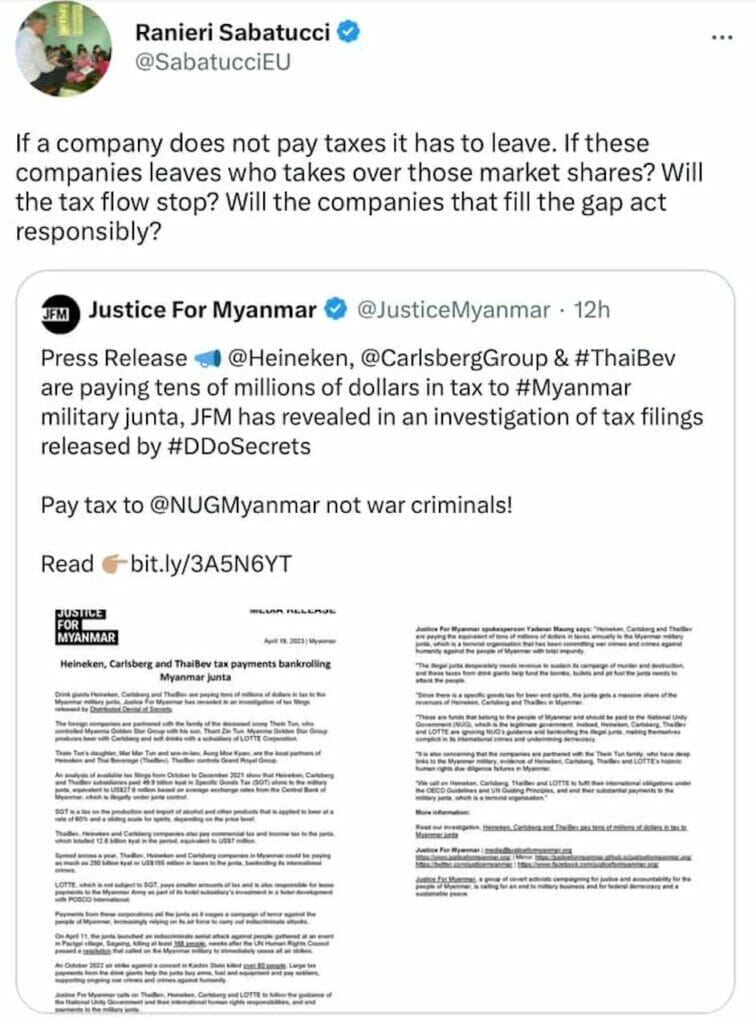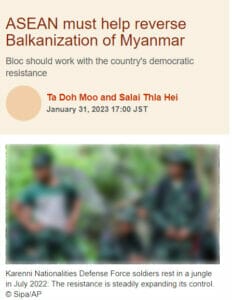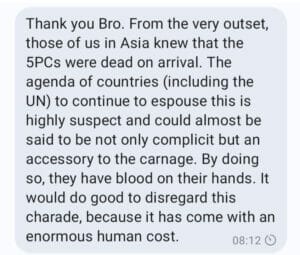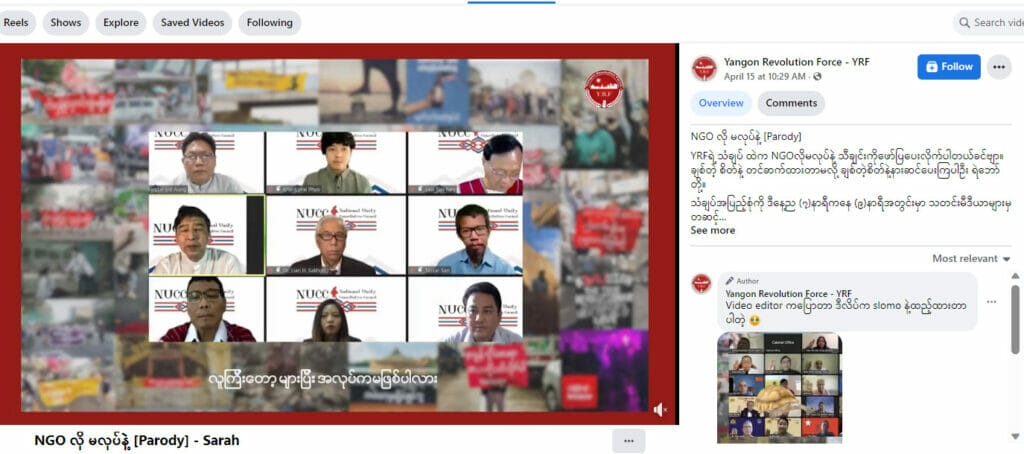“Who will replace the military to hold Myanmar together?” This is the paramount question which looms large among those who think, operate, and interact in “state spaces”, that is, the international policy circles of diplomats, UN bureaucrats, think tankers, geo-strategists, and military planners, as well as business lobbyists.
Regarding Myanmar, the prevailing policy presumption seems to be as follows: in ethnically fractious states such as Myanmar where the state is violently contested by multiple populations or “stakeholders,” the central military known as the Tatmadaw is stabilizer, the firm hand that keeps the country together. Whatever its crimes – including genocide and other atrocious crimes – all recurring and systemic, the military has been tolerated, within the ASEAN, for instance, at least until the coup two years ago.
For its systemic human rights and atrocity crimes are not seen as having any disruptive impact on international trade, commerce and strategic interests of neighbours and other powerful external actors.
This sadly reflects the rather regressive Westphalian thinking among those who speak on behalf of different external “state actors”.
A cursory glance at the Wikipedia entry of the Westphalian ideology of the sacrosanct or absolutist sovereignty of the states, as opposed to the people, is in order. The introduction of the entry reads:
The Westphalian system, also known as Westphalian sovereignty, is a principle in international law that each state has exclusive sovereignty over its territory. The principle underlies the modern international system of sovereign states and is enshrined in the United Nations Charter, which states that “nothing … shall authorize the United Nations to intervene in matters which are essentially within the domestic jurisdiction of any state.
According to the principle, every state, no matter how large or small, has an equal right to sovereignty.[2] Political scientists have traced the concept to the Peace of Westphalia (1648), which ended the Thirty Years’ War (1618–1648) and Eighty Years’ War (1568–1648).
Outside the neo-Westphalian state circles, the question of who will hold Myanmar together if the military are to be replaced confronts Myanmar’s anti-dictatorship dissidents. They/we are envisaging and fighting for “another Myanmar” where what ASEAN leaders officially refer to as “the largest military force”, no longer has monopoly grip over the country’s politics, economy, and society.
The difference between those who are in the spaces of “state think” and the “another Myanmar is possible” revolutionaries on the ground is this: unlike the international policy makers who embrace the“stability, right or wrong” stance towards Myanmar’s military, the instrument of genocide and terror, Myanmar, both the public and the dissidents, no longer believe and accept the military as their national armed forces.
Blood-soaked post-genocidal and post-civil war Cambodia is a pertinent case study for all Myanmar. Whatever the form of the Hun Sen government today, the Cambodian strategy – called Win-Win – of replacing the Pol Pot’s genocidal troops with the Hun Sen-led new Cambodian people’s army while integrating all those rank and file, including Khmer Rouge officers, might offer a promising model.
Last year, during Cambodia’s ASEAN Chairship, (Sao) Harn Yawnghwe, the founding director of the Associates to Develop Democratic Burma, better known as the Euro-Burma Office, and I travelled to Cambodia to learn how Cambodians and their international friends brought the bloody civil war to a close in their post-genocide society. We studied their “Win-Win Strategy” by which Vietnam-backed and Hun Sen-led anti-genocidal forces and Khmer Rouge genocidal military forces, supported by US, China and ASEAN, were integrated into a single national armed forces, something most relevant to our country with two dozen ethnic and pro-democracy armed forces.
We are grateful to our Cambodian friends who made serious efforts to help with finding a peaceful Win-Win in a post-genocidal, civil war-torn Myanmar.

The gathering of the two generation of exiles and revolutionaries at Harpers’ Ferry, West Virginia, USA, February 1999. (Professor Kyaw Win, the late Dr Vun Sum, Naw May Oo Mutraw, Shan State Army commander and Shan scholar the late Dr Chao Tzang Yawnghwe, the exiled Prime Minister of the National Coalition Government of the Union of Burma Dr Sein Win, the late Dr Marjolaine Law-Yone (Tin Nyo), Dr Maran Laraw, Dr and ex-Captain Thaung Tun, Zaw Oo, Dr Kyi May Kaung, Harn Yawnghwe and Maung Zarni, with an American dialogue facilitator.)
We know full-well what happened in Iraq when the entire national armed forces were dismantled – ala Saddam’s armed forces in the name of “regime change”. As Myanmar we have the greatest concerns for anarchy, chaos and more violence that may befall our people in transitional periods.
Despite our different ethnic and religious backgrounds, and political choices, (Harn Yawnghwe and) I have worked closely over the last 25 years, and seen mutual appreciation and respect. Besides our circles, there are other dissidents and revolutionaries who have studied other transitional societies and systems.
What Myanmar lack is not human talents or revolutionary experiences, but the international solidarity, especially solidarity from across different neighbours.
One step towards, or one concrete form, offering Myanmar resistance its due solidarity is to re-assess this pervasive regressively Westphalian view that Myanmar military is the only organization capable of holding the country together, despite the overwhelming evidence to the contrary.
The military under Min Aung Hlaing is proven to be the main de-stabilizer. It has violently deported nearly 1 million Muslim Rohingyas across the border onto Bangladeshi soil. In 24 months since the coup, its scorched-earth military operations have resulted in nearly 2 million war-fleeing refugees – called Internally Displaced Persons – in many regions of the country. It has caused the collapse of the country’s informal economy which provided the majority of the people with livelihoods. It is the main cause of shame for ASEAN as its credibility has become the butt of international jokes.
Have a glance at the history of Khmer Rouge and see how it came about, who and how it was sustained and supported in the 1970’s , and how it was treated as the legitimate representative of Cambodia even after the facts of genocide came to light, well into the 1980’s. It swept into power amidst the carpet-bombing of Northern Vietnam and parts of Cambodia. It was financially sustained by China. And Singapore provided the genocidal regime with fuel and helped generate foreign income by purchasing Cambodia fish wholesale. The United States and the United Kingdom gave blanket veto protection at the UN in New York. Thailand gave sanctuary to Pol Pot and his deputies to fight back the anti-genocidal forces of Hun Sen from their Thai-Khmer border based. ASEAN served as the genocidal regime’s lobbyist in the international circles of state actors.
As my Khmer brother Youk Chhang who directs the Documentation Center – Cambodia, put it, “although 2 million Cambodians were killed, 5 million of us survived and live to rebuild Cambodia.”
Yes, Myanmar people are certainly victims of our own internal colonial regime that has turned genocidal towards different communities. As is typically the case with all genocidal regimes, there are also more than one group that suffered Myanmar military’s crimes.
Additionally, we are also the victims of the emerging geopolitics. But Myanmar people of all classes and ethnicities deserve a lot more credit to their resilience than they are given. We have preserved, against all odds, for six decades. We resent being seen and treated as mere subject of pity of sympathy.
No other Asian society has lived 70+ years of civil war and state-directed repression. The three generations of Myanmar of all ethnic backgrounds – not just the Karens or Shan or Rakhine but the Bama Buddhists and communists alike – continue to struggle for another better Myanmar. We are not the people that ASEAN or the world should offer platitudes of sympathy. We don’t want your sympathy. We demand solidarity as we have given our neighbours, far and near, a hand of solidarity, be they Indonesians seeking to expel their Dutch colonizers in the late 1940’s or the East Pakistanis – now Bengali – in their War of Liberation in 1971. (Ask the Rohingyas about the solidarity and refuge they offered their anthropological kin across the border in Tek Naf and Cox’s Bazaar.)
In the face of the dissolution of political parties, birthing and deaths of armed organisations, or wholesale purges of dreaded military intelligence services, scorched-earth operations – known as the Four Cuts – and airstrikes, both the Myanmar resistance and the public at large remain defiant and determined to create a better future for themselves and the generations to come.
They/we will survive even if the military and its structures are radically overhauled to reinvent this institution as a force that protects its peoples, not perpetrate heinous crimes against the people in whose name it justifies its existence.
This unacceptability of the military as it has existed in this repressive, predatory form, permeates the public thinking, irrespective of class, race/ethnicity, age group, gender, or religion. It is based on their decades-old painful experience of life under the boot.
There is also another irreconcilable difference in Myanmar public’s consensus view and the general consensus among external actors who typically operate in the state spaces – ASEAN, UN, EU, and so forth.
Despite its genocides – note the plural, judicially recognized or not – war crimes, and crimes against humanity, external actors continue to view the military as a legitimate stakeholder of Myanmar. They are still doing business with the military, albeit with a bit more public relations sensitivity: for regional stability; for military and intelligence cooperation; for trade and commerce; for geopolitical equations.

European Union Representative to Myanmar His Excellency Ranieri Sabatucci officially justifies EU companies doing business in Myanmar while the coup regime is committing mass atrocities against civilians, April 2023.
This is an unacknowledged international consensus.
From a Myanmar people’s perspective, this consensus is not only profoundly problematic – not simply because of the black-and-white moral thought or popular idealistic goal of Myanmar as “a genuinely federal democracy”, but this consensus among external actors comes at enormous human cost to Myanmar.
In sharp contrast, Myanmar people of different ethnic nations which really are the bases of Myanmar as a political state, or a post-colonial country, view the existing military of the coup regime as a Fascist-like alien occupier whose stay in power at best and a mafia-like crime syndicate at worst.
 Accordingly, Myanmar activists from within different resistance networks, armed and peaceful, have been intensely engaged in the process of envisaging multiple scenarios, including what would be the end game. Some articulated their national vision for all, despite their ethnic minority backgrounds.
Accordingly, Myanmar activists from within different resistance networks, armed and peaceful, have been intensely engaged in the process of envisaging multiple scenarios, including what would be the end game. Some articulated their national vision for all, despite their ethnic minority backgrounds.
Their debate is as to when and under what circumstances is the dialogue acceptable in their conscience, with the well-documented perpetrators of all crimes ever encoded in domestic and international criminal law. Who will sit at the table? What are the preconditions for sitting down with the killers of their children, arsonists of their villages, bombers of their relatives, rapists of their mothers, sisters, wives and friends, executioners of their comrades and their former torturers and jailors? When is the time to attend cocktails with the generals and ex-generals of this criminal military who bear the command responsibility for more-than-half-century of crimes against citizens?
They ask among themselves many concrete scenario-based questions including, “will we talk to the killers, when they are holed up in their N. Korean-made underground bunkers in the fortified capital Naypyidaw and feel compelled to seek an exit?”
Myanmar people know and appreciate that there are well-meaning state functionaries – and even state leaders – who stand with them in their hours of need. Statements of concerns, condemnations, a long dribble of targeted economic sanctions, humanitarian dollars, etc., are welcome. Gratitude is expressed when it is due.

A message from Myanmar
But the objective reality is this: the best the international associations – ASEAN or EU or UN – can do is not good, or effective enough for Myanmar people. Despite the Security Council’s endorsement, “ASEAN’s 5 Point Consensus” falls far short of what is vitally needed to bring about the meaningful change, to stem the tide of violence and to bring all actors at the dialogue table. From the perspective of Myanmar people who live the realities of life in their blood-soaked country where the most powerful armed organization – the formerly national armed forces – the public generally do not and cannot accept their mass-killers as a stakeholder. On its part, the regime has labelled “terrorist and terrorist sympathizer” anyone and community who dares to openly oppose the coup and vowed to annihilate the anti-coup communities by scorch-earthing and bombing civilians and resisters alike from the air any community of resistance.
To be sure, post-Aung San Suu Kyi-leadership and NLD party, there has not emerged a single umbrella entity. There is no Myanmar equivalent of a Mandela’s ANC-like post-apartheid entity which could offer the majority of the wretched of Myanmar, of all ethnic and religious backgrounds, alternatives to the highly centralized unitary political state, under the monopoly grip of successive cliques of men in generals’ uniform. As some foreign experts on Myanmar pointed out, Myanmar resistance movements – note the plural – today do not have a single charismatic leader who can perform like Ukraine’s Zalensky, a TV actor-cum-politician.
Well, that’s not a bad thing for Myanmar for two concretely Myanmar-specific reasons.
First, for a quarter of a century, we had Aung San Suu Kyi who had been likened with Mandela, MLK Jr., Mother Theresa, and Mohandas Gandhi. We know how that fairy tale of Mother of the nation ended – as the defender and denier of the genocide at the UN’s highest court in The Hague. She turned into a cultist figure, while her Bama-centric politics aligned with the genocidal military had further disunited Myanmar’s majoritarian and ethnic minority communities.
If anything, the anti-coup movement has forced millions of Bama chauvinists to reassess their internal racisms towards non-Bama peoples, including the genocide targeted Rohingya. This is a welcomed and unprecedented development. It bodes well for an anti-racist federalist democracy where the majority no longer view as “normal” or justified to have the monopoly over the state and state organizations.
Second, the society is undergoing a progressive social transformation where the new generation of armed resisters and dissidents are comfortable and effective as loose and organic concentric networks with localized leaderships.
There is more to Myanmar today than the armed resistance, the bloodshed, the grinding poverty, ethnic division and a the humanitarian basket case of the ASEAN. Driven by the younger generation of Myanmar, the society at large is concurrently undergoing a value transformation, or “social revolution” rejecting the old sexist, racist, bigoted and authoritarian perspectives of their parents and grandparents.
From day one of the resistance two years ago, dissidents inside and outside of Myanmar discussed the idea of post-dictatorship armed forces – a federal army, for instance – as a force that protects, not perpetrates crimes against its own people. Led by an older generation of dissidents and revolutionaries, a generation of Myanmar dissidents were engaged in the constitution drafting at both federal and state levels 20 years ago.
In the first year of the anti-coup resistance movement in 2021, the multiple ethnic and class representatives have proven themselves capable of drafting and adopting the Federal Democratic Constitution, which enjoy broad support from both the old NLD supporters speaking for the Bama Buddhist majority and the non-Bama ethnic communities including some of the most important political parties such as the Shan National League for Democracy.
Finally, a word about the National Unity Government (NUG) that has emerged as the organizational face of the anti-coup armed resistance.
During the Myanmar New Year Festival a week ago, two major groups became subjects of intense ridicule and criticism in the form of customary social and political satirical performances delivered on the social media. One is the coup regime and its military which has been trashed as a Fascist criminal gang of looters, rapists, robbers, killers and thugs. The other is the NUG. The satire ridiculed the NUG for behaving like an NGO since its inception, portraying it as holding endless Zoom meetings, ruling the country from the air – as opposed the military bombing it from the air – and engaging in the gesture politics of the Three Fingers.

Watch the Burmese New Year customory satire here: https://fb.watch/k3qqyLqIMg/
Certainly, NUG needs a serious overhaul – a reform if you will – of its make-up to form a credible revolutionary leadership. The leadership criterion should not be party loyalty to the racist chauvinistic National League for Democracy party.
Ex-genocide cheerleaders or deniers, or low calibre Suu Kyi-loyalists who surround themselves with old friends and former Myanmar NGO workers do not even impress Myanmar satirical artists, just as they have not impressed any serious persons, state officials, ethnic revolutionaries or serious Bama dissidents.
But NUG is NOT the alternative structure or even organization that will replace Myanmar’s murderous military. If international state actors are looking at the NUG – and reach the conclusion that it is not the winning horse capable of holding the strife-torn country together, they were looking for the answer in the wrong place.
Myanmar local communities of resistance, in collaboration with, yes, both NUG and the ethnic armed organizations, are building state structures from the ground up, in accord with the ethos of devolution or decentralization of local self-governance. Many of these local communities work with the Chin National Front, Kachin Independence Organization, Arakan Army, the Karen National Union, the Karenni National Progressive Party, and so on, who actively opposed to the coup regime. Even the Restoration Council of Shan State and the United Wa State Army have a functioning truce with the military in Naypyidaw run their own administration, without needing any nod from the military.
By its own admission Myanmar’s largest military force – the second largest after Vietnam’s in mainland Southeast Asia – is losing control, territorially and administratively – within the relative short period of 24 months. The regime is being replaced in the 40% of the total of 330 townships, according to Major General Zaw Min Htun who confessed this loss of administrative control in his recent Al Jazeera English interview on Talk to Al Jazeera.
The regions of Myanmar that the regime has lost control of do not descend into chaos or anarchy. Quite the contrary, new structures of local administrations have replaced their repressive administrations which were set up at gunpoint.
The unfolding of building local administrative structures – really a state and democracy building from the bottom-up – is the loudest and convincing answer to that “Who will replace the military in Myanmar? – that Myanmar peoples have provided to the international community of states.
It will certainly take some time for those who operate in “state spaces” and do “state speak” to understand and fully appreciate that in the 21st century, people, not the militaries or kings or autocrats – keep countries together. Like Cambodia before us, Myanmar too will be a case study of how the wretched of Asia proved capable of rebuilding their post-genocidal civil war-torn society.
The sooner international actors realise this, then the better it will be for everyone – for international trade, for boundary integrity, for human rights.
Maung Zarni
